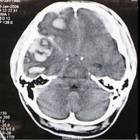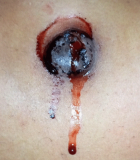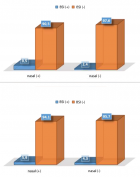Abstract
Research Article
Incidence and outcome of no flow after primary percutaneous coronary intervention in acute myocardial infarction
Goutam Datta*
Published: 31 August, 2020 | Volume 5 - Issue 2 | Pages: 153-156
Background: Primary percutaneous coronary intervention (PCI) of the infarct-related artery (IRA) is the most effective treatment modality in ST-segment elevation myocardial infarction (STEMI). Incidence of no flow is 8.8% - 10% in primary PCI of STEMI patients. Our aim was to study actual incidence and outcome of no flow patients.
Methods: Five hundred and eighty primary PCI patients were enrolled and evaluated from 2016 January to 2017 December.
We used drug eluting stents in all cases. Majority of our patients (> 90%) presented to emergency six hours after onset of symptoms. There were many patients where there was no flow even after mechanical thrombus aspiration and pharmacological vasodilator therapy. We have studied primary outcome (mortality) of no flow in those patients.
Results: There were 44 cases of no flow in our series (7.75%). Involvement of Left anterior descending artery (LAD) was in eighteen patients. Right coronary artery (RCA) was culprit in twenty four cases. Only two cases were seen in LCX territory. One month mortality rate in no flow group was 50% and 6.25% in successful recanalization group. One year mortality was 12.5% in successful recanalization group and 66% in no flow group.
Conclusion: Refractory no flow during STEMI intervention is associated with increased incidence of major adverse cardiovascular events (MACE).
There is no established strategy to solve this phenomenon.
Read Full Article HTML DOI: 10.29328/journal.jccm.1001102 Cite this Article Read Full Article PDF
Keywords:
Primary PCI; No flow; Mortality
References
- Prasad S, Meredith IT. Current approach to slow flow and no Reflow. Cardiac Interventions Today. 2008; 43-49.
- Triantafyllou K, Metaxopoulos P, Babalis D. Primary percutaneous coronary intervention of an unprotected left main using mini-crush drug-eluting stents facilitated by intracoronary reteplase. Catheter Cardiovasc Interv. 2011; 77: 515-521.
- Rezkalla SH, Dharmashankar KC, Abdalrahman IB, Kloner RA. No-reflow phenomenon following percutaneous coronary intervention for acute myocardial infarction: incidence, outcome, and effect of pharmacologic therapy. J Interv Cardiol. 2010; 23: 429–436. PubMed: https://pubmed.ncbi.nlm.nih.gov/20819117/
- Wang HJ, Lo PH, Lin JJ, Lee H, Hung S. Treatment of slow/no-reflow phenomenon with intracoronary nitroprusside injection in primary coronary intervention for acute myocardial infarction. Catheter Cardiovasc Interv. 2004; 63: 171–176. PubMed: https://pubmed.ncbi.nlm.nih.gov/15390241/
- Amano H, Ikeda T, Toda M, Okubo R, Yabe T, et al. Plaque composition and no-reflow phenomenon during percutaneous coronary intervention of low-echoic structures in grayscale intravascular ultrasound. Int Heart J. 2016; 57: 285–291. PubMed: https://pubmed.ncbi.nlm.nih.gov/27170472/
- Iwakura K, Ito H, Ikushima M, Kawano S, Okamura A, et al. Association between hyperglycemia and the no-reflow phenomenon in patients with acute myocardial infarction. J Am Coll Cardiol. 2003; 41: 1–7. PubMed: https://pubmed.ncbi.nlm.nih.gov/12570936/
- Li X, Yang Y, Hao Y, Yang Y, Zhao J, et al. Effects of pre-procedural statin therapy on myocardial no-reflow following percutaneous coronary intervention: A Meta-analysis. Chin Med J. 2013; 126:1755–1760. PubMed: https://pubmed.ncbi.nlm.nih.gov/23652063/
- Grygier M, Araszkiewicz A, Lesiak M, Grajek S. Role of adenosine as an adjunct therapy in the prevention and treatment of no-reflow phenomenon in acute myocardial infarction with ST segment elevation: review of the current data. Kardiologia Poloska. 2013; 71: 115–120.
- Higashi H, Inaba S, Nishimura K, Hamagami T, Fujita Y, et al. Usefulness of Adjunctive Pulse Infusion Thrombolysis After FailedAspiration for Massive Intracoronary Thrombus. Canadian J Cardiol. 2011; 27: 869- 869.
- Rezkalla SH, Stankowski RV, Hanna J, Kloner RA. Management of No-Reflow Phenomenon in the Catheterization Laboratory. JACC: Cardiovasc Interv. 2017; 10: 215-223. PubMed: https://pubmed.ncbi.nlm.nih.gov/28183461/
Figures:

Figure 1

Figure 2

Figure 3

Figure 4
Similar Articles
-
Left Atrial Remodeling is Associated with Left Ventricular Remodeling in Patients with Reperfused Acute Myocardial InfarctionChristodoulos E. Papadopoulos*,Dimitrios G. Zioutas,Panagiotis Charalambidis,Aristi Boulbou,Konstantinos Triantafyllou,Konstantinos Baltoumas,Haralambos I. Karvounis,Vassilios Vassilikos. Left Atrial Remodeling is Associated with Left Ventricular Remodeling in Patients with Reperfused Acute Myocardial Infarction. . 2016 doi: 10.29328/journal.jccm.1001001; 1: 001-008
-
Indications and Results of Coronarography in Senegalese Diabetic Patients: About 45 CasesNdao SCT*,Gaye ND,Dioum M,Ngaide AA,Mingou JS,Ndiaye MB, Diao M,Ba SA. Indications and Results of Coronarography in Senegalese Diabetic Patients: About 45 Cases. . 2017 doi: 10.29328/journal.jccm.1001007; 2: 013-019
-
Procedure utilization, latency and mortality: Weekend versus Weekday admission for Myocardial InfarctionNader Makki,David M Kline,Arun Kanmanthareddy,Hansie Mathelier,Satya Shreenivas,Scott M Lilly*. Procedure utilization, latency and mortality: Weekend versus Weekday admission for Myocardial Infarction. . 2017 doi: 10.29328/journal.jccm.1001008; 2: 020-025
-
Non-hemodynamic factors associated to the risk of developing hypertensive cardiopathyAlexis Álvarez-Aliaga*,Julio César González-Aguilera,Liliana del Rosario Maceo-Gómez,Lic David del Llano Sosa,Raúl Leyva-Castro,Rosa Ojeda-Vázquez. Non-hemodynamic factors associated to the risk of developing hypertensive cardiopathy. . 2017 doi: 10.29328/journal.jccm.1001017; 2: 068-084
-
Design and validation of an Index to predict the development of Hypertensive CardiopathyAlexis Álvarez-Aliaga*,Andrés José Quesada-Vázquez,Alexis Suárez-Quesada,David de Llano Sosa. Design and validation of an Index to predict the development of Hypertensive Cardiopathy. . 2018 doi: 10.29328/journal.jccm.1001022; 3: 008-022
-
Cardiovascular damage during lupus in black African subjectsYaméogo NV*,Tougouma SJ-B,Zabsonré J,Kologo KJ,Tiemtoré WS,Kagambèga LJ,Bagbila WPAH, Traoré A,Samadoulougou AK,Zabsonré P. Cardiovascular damage during lupus in black African subjects. . 2018 doi: 10.29328/journal.jccm.1001024; 3: 031-034
-
Timing of cardiac surgery and other intervention among children with congenital heart disease: A review articleChinawa JM*,Adiele KD,Ujunwa FA,Onukwuli VO,Arodiwe I,Chinawa AT,Obidike EO,Chukwu BF. Timing of cardiac surgery and other intervention among children with congenital heart disease: A review article. . 2019 doi: 10.29328/journal.jccm.1001047; 4: 094-099
-
Prevalence of congenital heart diseases among primary school children in the Niger Delta Region of Nigeria, West AfricaUjuanbi Amenawon Susan*,Tabansi Petronilla Nnena,Otaigbe Barbara Edewele. Prevalence of congenital heart diseases among primary school children in the Niger Delta Region of Nigeria, West Africa. . 2019 doi: 10.29328/journal.jccm.1001056; 4: 144-149
-
Evaluation of the predictive value of CHA2DS2-VASc Score for no-reflow phenomenon in patients with ST-segment elevation myocardial infarction who underwent Primary Percutaneous Coronary InterventionMahmoud Shawky Abd El-Moneum*. Evaluation of the predictive value of CHA2DS2-VASc Score for no-reflow phenomenon in patients with ST-segment elevation myocardial infarction who underwent Primary Percutaneous Coronary Intervention. . 2019 doi: 10.29328/journal.jccm.1001061; 4: 171-176
-
Do beta adrenoceptor blocking agents provide the same degree of clinically convincing morbidity and mortality benefits in patients with chronic heart failure? A literature reviewMartin Mumuni Danaah Malick*. Do beta adrenoceptor blocking agents provide the same degree of clinically convincing morbidity and mortality benefits in patients with chronic heart failure? A literature review. . 2019 doi: 10.29328/journal.jccm.1001063; 4: 182-186
Recently Viewed
-
Pneumothorax as Complication of CT Guided Lung Biopsy: Frequency, Severity and Assessment of Risk FactorsGaurav Raj*,Neha Kumari,Neha Singh,Kaustubh Gupta,Anurag Gupta,Pradyuman Singh,Hemant Gupta. Pneumothorax as Complication of CT Guided Lung Biopsy: Frequency, Severity and Assessment of Risk Factors. J Radiol Oncol. 2025: doi: 10.29328/journal.jro.1001075; 9: 012-016
-
The Police Power of the National Health Surveillance Agency – ANVISADimas Augusto da Silva*,Rafaela Marinho da Silva. The Police Power of the National Health Surveillance Agency – ANVISA. Arch Cancer Sci Ther. 2024: doi: 10.29328/journal.acst.1001046; 8: 063-076
-
A Comparative Study of Serum Sodium and Potassium Levels across the Three Trimesters of PregnancyOtoikhila OC and Seriki SA*. A Comparative Study of Serum Sodium and Potassium Levels across the Three Trimesters of Pregnancy. Clin J Obstet Gynecol. 2023: doi: 10.29328/journal.cjog.1001137; 6: 108-116
-
Chaos to Cosmos: Quantum Whispers and the Cosmic GenesisOwais Farooq*,Romana Zahoor*. Chaos to Cosmos: Quantum Whispers and the Cosmic Genesis. Int J Phys Res Appl. 2025: doi: 10.29328/journal.ijpra.1001107; 8: 017-023
-
Phytochemical Compounds and the Antifungal Activity of Centaurium pulchellum Ethanol Extracts in IraqNoor Jawad Khadhum, Neepal Imtair Al-Garaawi*, Antethar Jabbar Al-Edani. Phytochemical Compounds and the Antifungal Activity of Centaurium pulchellum Ethanol Extracts in Iraq. J Plant Sci Phytopathol. 2024: doi: 10.29328/journal.jpsp.1001137; 8: 079-083
Most Viewed
-
Evaluation of Biostimulants Based on Recovered Protein Hydrolysates from Animal By-products as Plant Growth EnhancersH Pérez-Aguilar*, M Lacruz-Asaro, F Arán-Ais. Evaluation of Biostimulants Based on Recovered Protein Hydrolysates from Animal By-products as Plant Growth Enhancers. J Plant Sci Phytopathol. 2023 doi: 10.29328/journal.jpsp.1001104; 7: 042-047
-
Sinonasal Myxoma Extending into the Orbit in a 4-Year Old: A Case PresentationJulian A Purrinos*, Ramzi Younis. Sinonasal Myxoma Extending into the Orbit in a 4-Year Old: A Case Presentation. Arch Case Rep. 2024 doi: 10.29328/journal.acr.1001099; 8: 075-077
-
Feasibility study of magnetic sensing for detecting single-neuron action potentialsDenis Tonini,Kai Wu,Renata Saha,Jian-Ping Wang*. Feasibility study of magnetic sensing for detecting single-neuron action potentials. Ann Biomed Sci Eng. 2022 doi: 10.29328/journal.abse.1001018; 6: 019-029
-
Pediatric Dysgerminoma: Unveiling a Rare Ovarian TumorFaten Limaiem*, Khalil Saffar, Ahmed Halouani. Pediatric Dysgerminoma: Unveiling a Rare Ovarian Tumor. Arch Case Rep. 2024 doi: 10.29328/journal.acr.1001087; 8: 010-013
-
Physical activity can change the physiological and psychological circumstances during COVID-19 pandemic: A narrative reviewKhashayar Maroufi*. Physical activity can change the physiological and psychological circumstances during COVID-19 pandemic: A narrative review. J Sports Med Ther. 2021 doi: 10.29328/journal.jsmt.1001051; 6: 001-007

HSPI: We're glad you're here. Please click "create a new Query" if you are a new visitor to our website and need further information from us.
If you are already a member of our network and need to keep track of any developments regarding a question you have already submitted, click "take me to my Query."

























































































































































